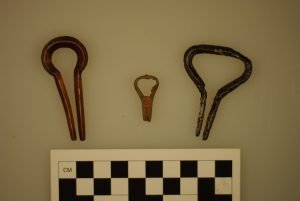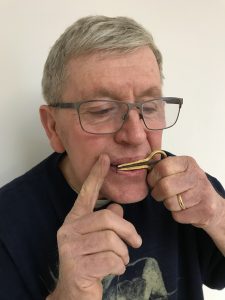

Some of the more interesting artifacts excavated semi-regularly by archaeologists at Michilimackinac are jaw harps. These small musical instruments, also known as a mouth harp or Jew’s harp (although they have no particular relation to Jewish people or Judaism), were common trade items at Michilimackinac in the 18th century.
Jaw harps are thought to have originated in Asia several thousand years ago. A simple instrument, they consist of a brass or iron frame, similar in shape to a tuning fork, with a steel spring between the tines. By placing the frame against their front teeth and flicking the spring, players can create a distinctive twanging sound. Different notes can be played by altering the shape of the player’s mouth. By the early 17th century, European traders regularly included them in cargoes of trade goods shipped to North America for use in the fur trade and other transactions with Native Americans. Native people, who took jaw harps in trade for furs, apparently did not use them as traditional musical instruments, instead viewing them as noisemaking toys. Being small, cheap, and easy to play, the instruments were popular with French and British colonists. They also appear to have been popular with soldiers for the same reasons, and could be used to easily accompany songs or other amusements in a barracks or camp. Although a jaw harp’s twang sounds stereotypically uncultured to modern ears, they were sometimes included in more formal musical compositions. The Austrian composer Johann Albrechtsberger, today remembered mostly for being one of Beethoven’s teachers, wrote several pieces for small orchestra and jaw harp in the late 1760s.
Over the past 59 summers, 172 jaw harps and jaw harp fragments have been excavated at Michilimackinac. Once the fragile center spring broke off, the frame was useless and was discarded. In the 18th century, European jaw harps came in a variety of shapes, from round-headed to triangular-headed. Round-headed brass jaw harps are the most common type found at Michilimackinac, but we find all combinations of material and shape. At the trader’s house we are currently excavating, we have found eight jaw harps, including three that are so small they could only have been used by a child. Children’s toys are rare archaeologically, so these have been exciting finds.


Some of the historic interpreters at Michilimackinac play jaw harps, so you can hear one of the sounds of the 18th century community when you visit. Original jaw harps, excavated by the archaeologists, are also on display in the Treasures from the Sand exhibit. We hope you’ll join us at Colonial Michilimackinac after the site opens on May 2 to see and hear these historic trade items.








